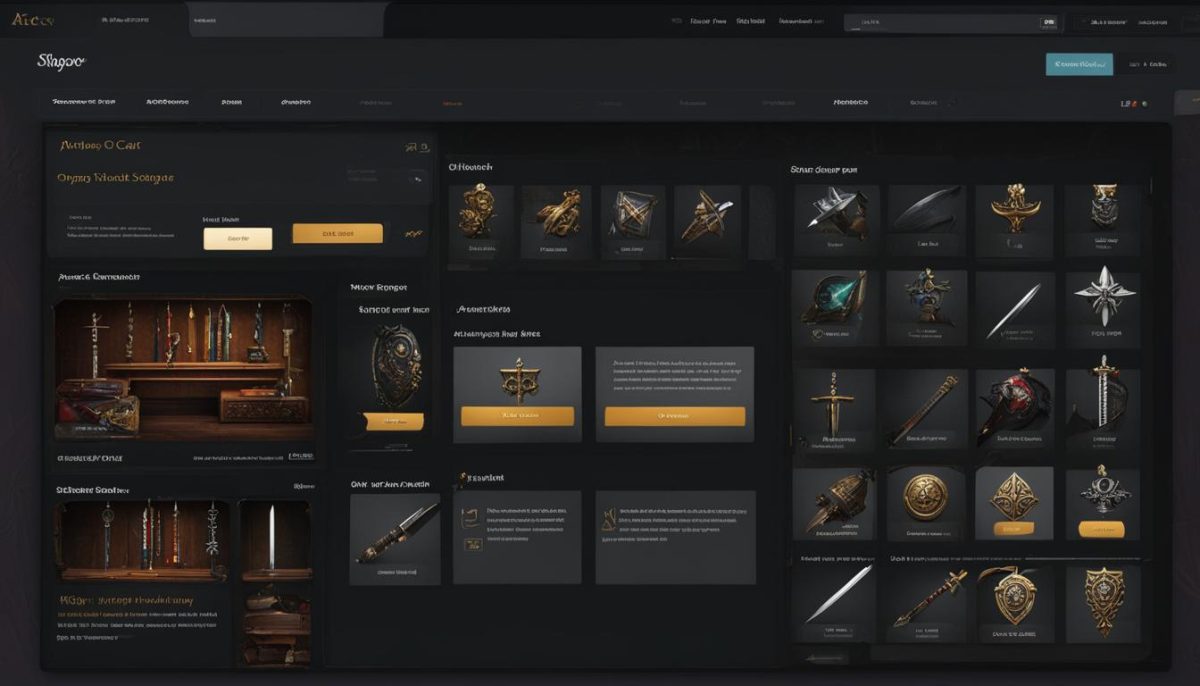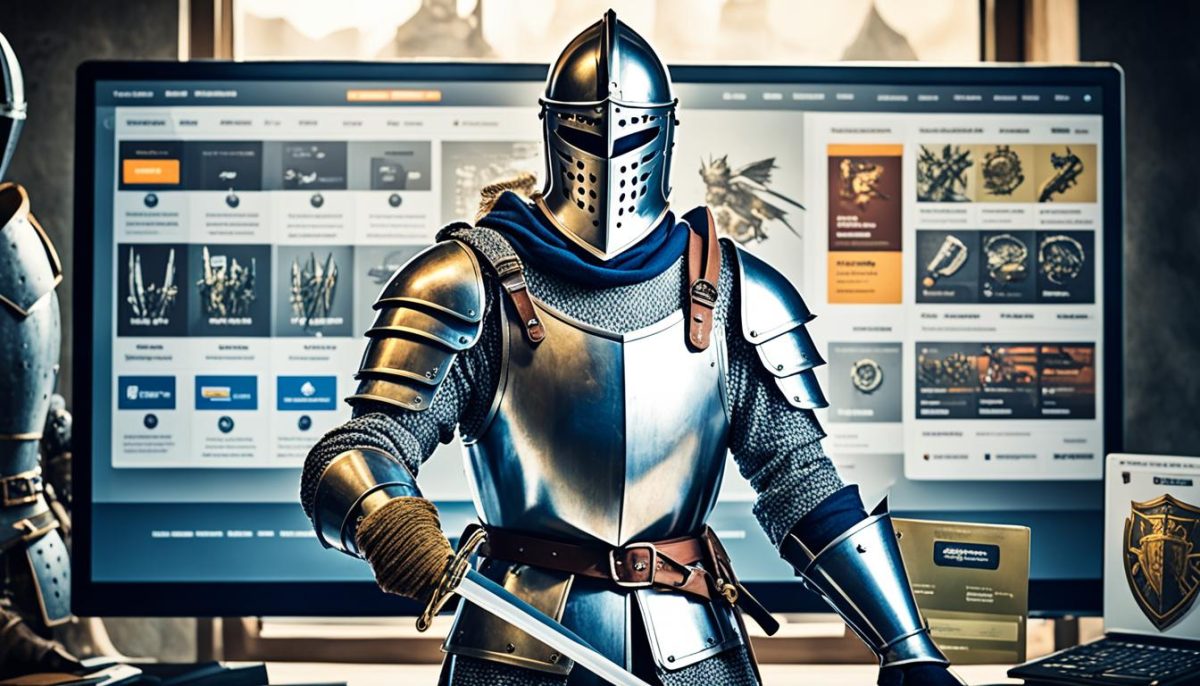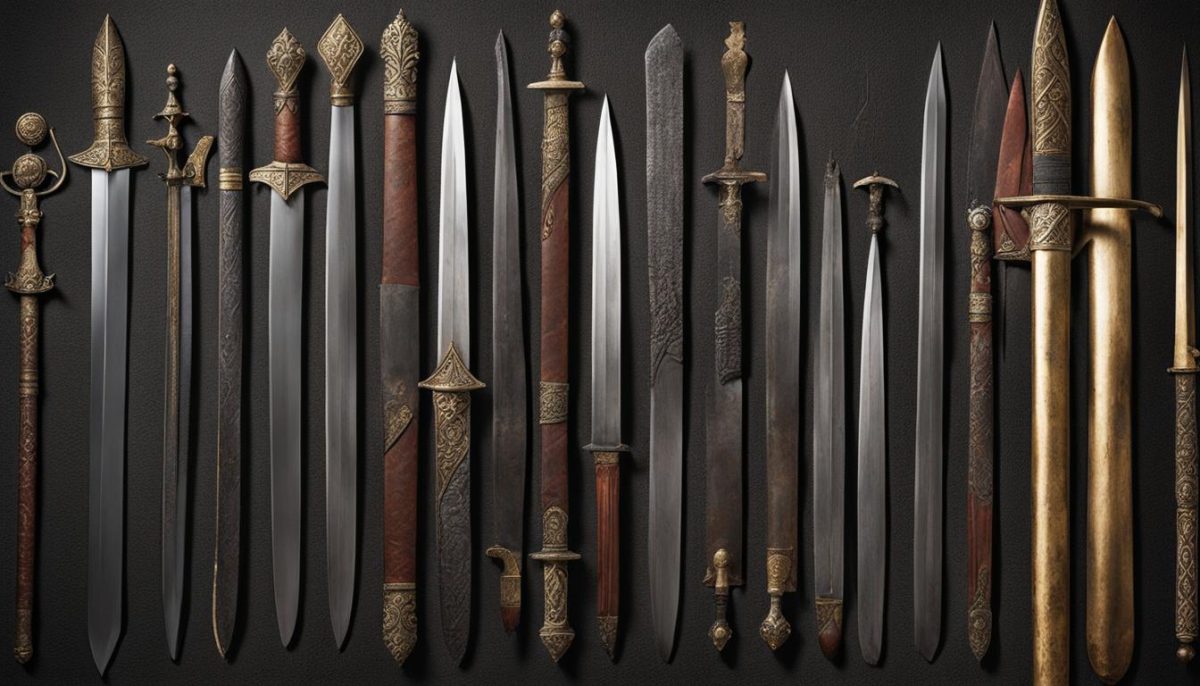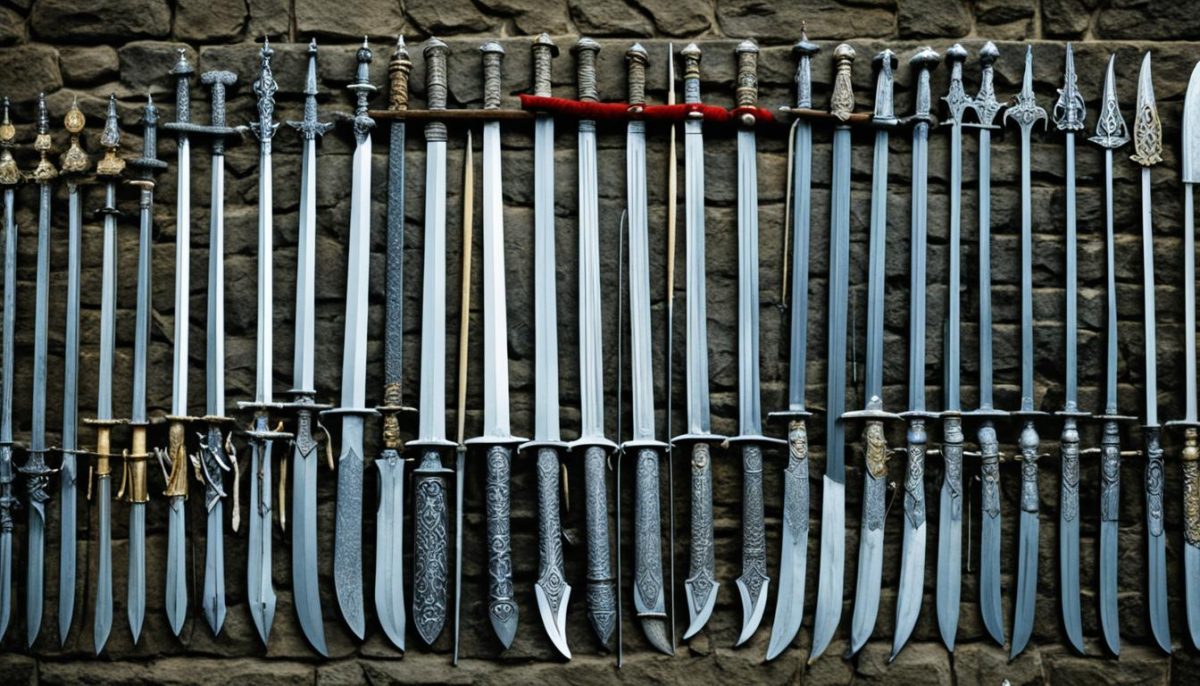Embarking on the quest to acquire a sword can be as thrilling as the stories blade wielders spun through the ages. Whether you’re a seasoned sword collector seeking antique swords that whisper tales of yore, a fencer in search of the perfect fencing swords for practice, or a sword enthusiast ready to buy medieval swords that bring history into your home, the hunt for the ideal blade is both an art and a science.
Enthusiasts searching for samurai swords for sale or collectors curious about the painstakingly forged replicas from historic battles often find themselves at a crossroads: the decision between the convenience of an online retailer and the tactile experience of a brick-and-mortar shop. Herein lies the joyous challenge for sword buffs: navigating through a crusade of options, where each type, style, and price point speaks to the grandeur of the sword’s legacy.
It’s worth noting that the path to the right sword purchase is paved with considerations. Authenticity checks, quality assurance, and aligning your budget with your needs—be it a robust blade or an ornamental piece—are all part of the adventure. For those ready to take up the mantle, the differences between an in-store purchase (where you can handle the swords and glean personal advice from experts) and an online acquisition (affording a wider selection, customer reviews, and often better prices) are key factors to ponder.
Stay with us as we unsheathe the secrets to finding the perfect sword, from the hallowed walls of specialized sword shops to the vast digital domain of online retailers—and, for the true connoisseur, the forge of the local blacksmith where artistry in metal is a tradition carried through the flames of time.
Finding the Right Sword for Your Needs
Embarking on a journey to find the perfect sword is akin to entering a rich historical tapestry. With countless types of swords woven into different cultures around the world, the allure of historical swords captivates the modern-day enthusiast. Moreover, the vivid imagination behind fantasy swords and movie replica swords adds a layer of excitement to collections. Whether your interests lie in practical use for martial arts or adding an elegant touch to your decor with decorative swords, the quest begins with understanding the diversity and purpose behind each blade.
Understanding Different Types of Swords
From the graceful curves of a Japanese katana to the imposing presence of a medieval broadsword, different sword types not only represent the eras and regions they hail from but are also engineered for specific martial techniques. Let’s delve into some renowned sword types:
- Katana – The soul of the samurai, characterized by its single-edged blade.
- Longsword – A staple in European history, balanced for both thrusting and cutting.
- Rapier – Popular in the Renaissance, designed primarily for thrusting.
- Broadsword – The broad, double-edged blade of the knightly class.
Selecting Swords Based on Your Personal Style
Your personal style and affinity toward a specific culture or era heavily influence your sword choice. Enthusiasts of European heritage may gravitate towards the iconic Excalibur or the Viking sword, while devotees of Eastern traditions might prefer the sleek lines of a Chinese jian. It’s not only the historical significance that matters; the aesthetics of the hilt, guard, and scabbard are crucial in reflecting your style.
Intended Use: Decorative vs. Functional Swords
When selecting your sword, ask yourself the primary purpose of your acquisition. Here’s a quick comparative guide to help you discern between functional and decorative swords:
| Feature | Decorative Swords | Functional Swords |
|---|---|---|
| Primary Use | Display and Aesthetics | Martial Arts, Reenactments |
| Material Quality | Varies, often lower | High-quality steel |
| Edge | Blunt | Sharpened for practical use |
| Balance and Weight | Not prioritized | Specific to historical accuracy and usability |
| Maintenance | Minimal | Regular upkeep for safety and preservation |
In essence, the distinction between swords designed to embellish one’s living space versus those crafted for tactile experience is vital. Safety measures for handling and adequate maintenance are integral in preserving the integrity and beauty of your chosen weapon.
Buy Swords Online: Top Retailers and Specialty Shops
Exploring the world of sword collecting can be an enriching experience, especially with the ease of access that online sword shops and sword retailers provide. A well-crafted sword is not just a weapon; it’s a piece of art, a slice of history, and a key to a community of enthusiasts. Whether you are a martial artist looking to practice with authenticity or a collector seeking to acquire collectible swords online, the digital realm has brought a variety of options to your fingertips.
When delving into the sword buying guide, consider the vast inventory offered by martial arts supply stores. They not only cater to practitioners of the art but also to historians and collectors. User-friendly websites have made browsing for swords a seamless experience. Accompanied by detailed product descriptions and high-resolution images, these platforms provide all the information a potential buyer might need.
Customer service experiences can make or break your online purchasing decision. The top-tier sellers prioritize customer support, offering advice, and addressing concerns regarding your purchase. Moreover, it’s paramount to review the return policies and consumer protections in place, ensuring a secure transaction and peace of mind.
Online reviews and community forums are invaluable resources, offering insights into the reputations of sword sellers. They provide firsthand accounts from fellow enthusiasts, which can guide you in making an informed purchase. Do invest time in this research; it’s worth its weight in gold—or in this case, steel.
Price comparisons are also vital. With an array of sellers, there’s a spectrum of pricing to navigate through. This competitive market often benefits the buyer, leading to more reasonable price points for high-quality swords. Pay attention to shipping options and handling fees as they can significantly affect the final cost. Below is a comparison table to help in evaluating the offerings of various noteworthy sword retailers:
| Retailer | User Experience | Product Range | Customer Service | Return Policy | Shipping & Handling |
|---|---|---|---|---|---|
| Legendary Blades | Straightforward navigation | Extensive, including rare items | Responsive, knowledgeable staff | 30-day returns | Variable rates, international available |
| Martial Arts Mart | Interactive, detailed filters | Focused on practical use swords | Live chat support | 45-day returns | Free shipping on orders over $100 |
| Antique Weaponry Hub | Classic, easy-to-use | Specialized in antiques and collectibles | Email and phone support | No-hassle returns within 15 days | Insured shipping, calculated at checkout |
This era of online shopping has revolutionized the way we acquire swords, offering the convenience of exploring collectible swords online from the comfort of home. Be it for display or demonstration, the perfect sword awaits you in the virtual marketspace.

Authentic Swords: Identifying Quality and Craftsmanship
The nuanced art of creating authentic swords is steeped in history and tradition, combining form and function in a way few other crafts can boast. Discerning sword enthusiasts appreciate the harmony of strength, balance, and aesthetics found in high-quality swords. These fundamental aspects elevate sword craftsmanship from mere metalworking to a form of expressive art aligned with centuries of traditional swordsmithing.
Materials and Design: What to Look For
Key indicators of quality in sword-making include the choice of sword materials and the precision of design. High-quality swords are typically forged from refined carbon steel or Damascus steel, renowned for their ability to hold a sharp edge and maintain structural integrity. The design of a sword directly influences its balance and durability, pivotal factors that determine a blade’s authenticity and functional capabilities.
Verifying Authenticity: Tips and Tricks
Discerning the authenticity of a sword involves examining several aspects beyond its physical appearance. Historical swords often bear a maker’s mark, a signature feature of a skilled swordsmith. Documentation and provenance further strengthen the authenticity of a blade. In contrast, fakes or replicas may appear similar but lack the depth of craftsmanship inherent in authentic swords. Comparing weights, checking for any signs of modern manufacturing, and consulting experts are all effective methods for verification.
The Importance of Craftsmanship in Sword Making
Traditional swordsmithing is a meticulous process that involves both time-honored techniques and intrinsic knowledge passed down through generations. The importance of this craftsmanship is evident in the resulting forged swords, where every hammer strike is a deliberate action contributing to the final product’s high quality. Skillful craftsmanship directly correlates with a sword’s performance—its durability, balance, sharpness, and even sound when wielded all tell the tale of the smith’s proficiency.
| Material | Characteristics | Common Use |
|---|---|---|
| Carbon Steel | Flexibility, durability, retains sharpness | Functional swords for martial arts |
| Damascus Steel | Distinctive patterns, edge retention, strength | Decorative and collector items |
Local Sword Shops and Blacksmiths in Your Area
Unearthing the skilled craftsmanship of local swordsmiths not only enriches your collection but also weaves a thread of support through the fabric of your community’s economy. By choosing to invest in the artisans around you, you’re participating in a sustainable cycle of commerce, all while being privy to the intricate creation process that is the hallmark of true blade making. Moreover, the custom swords and artisan-crafted swords you acquire come with a story, a provenance that is as unique as the blade itself.
Why Support Local Swordsmiths
Supporting local blacksmiths extends beyond transacting for goods; it’s about cultivating an environment where traditional skills thrive. The economic impact of keeping your hard-earned dollars within the community stimulates local business growth. By opting for a hand-forged sword from your neighbourhood, you’re championing sustainability and reducing the carbon footprint typically associated with long-distance transportation of commercial goods.
Finding Hidden Gems: Local Shops and Artisans
Local sword shops are often treasure troves just waiting to be discovered. With a dash of curiosity and some research, you can uncover these establishments, where swordsmiths may offer customizations that express your individual style. Through forging local connections, you gain access to uniquely crafted pieces that can’t be found in mainstream markets. These shops often serve as archives of historical knowledge and as custodians of the crafting lore that has been passed down through generations.
Building a Relationship with Your Local Blacksmith
There’s a special kinship that forms when you frequent and support a local smith. These relationships can lead to tailored advice fitting your specific needs, whether it’s for maintenance, repairs, or even custom blade creation. Additionally, for those with a genuine interest in the craft, local artisans may offer apprenticeship opportunities, providing a window into the world of sword making that is rich with tradition and technique. In essence, a bond with your local blacksmith unlocks a realm of personalized service and knowledge, making every visit a valuable experience.


